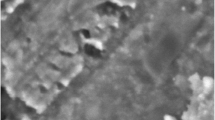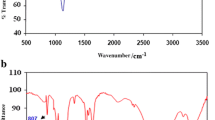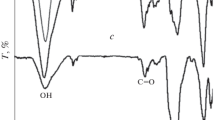Abstract
An ionic liquid-type carbon paste electrode (CPIE) was fabricated from 1-butyl-3-methylimidazolium hexafluorophosphate mixed with paraffin oil as the binder. The electrochemistry of Aloe-emodin (AE) at the electrode was investigated at pH 1.0 by cyclic voltammetry and differential pulse voltammetry. The ionic liquid as a binder distinctly enhances the electron transfer rate between AE and the electrode. A redox mechanism is discussed. The CPIE showed good sensitivity, selectivity and stability, and was applied to determine the concentration of AE. Under the optimal conditions, the oxidative peak current increased linearly with the concentration of AE in the range from 10 nM to 12.4 µM, with a correlation coefficient of 0.9973. The detection limit is 3.0 nM (at S/N = 3).





Similar content being viewed by others
References
Zhao F, Wu X, Wang MK, Liu Y, Gao LX, Dong SJ (2004) Electrochemical and bioelectrochemistry properties of room-temperature ionic liquids and carbon composite materials. Anal Chem 76:4960–4967
Wang SF, Xiong HY, Zeng QX (2007) Design of carbon paste biosensors based on the mixture of ionic liquid and paraffin oil as a binder for high performance and stabilization. Electrochem Commun 9:807–812
Law MC, Wong KY, Chan TH (2005) Formation and reactions of alkylzinc reagents in room-temperature tonic liquids. J Org Chem 70:10434–10439
Heitzman H, Young BA, Rausch DJ, Rickert P, Stepinski DC, Dietz ML (2006) Fluorous ionic liquids as solvents for the liquid–liquid extraction of metal ions by macrocyclic polyethers. Talanta 69:527–531
Maleki N, Safavi A, Tajabadi F (2006) High-performance carbon composite electrode based on an ionic liquid as a binder. Anal Chem 78:3820–3826
ShangGuan XD, Zhang HF, Zheng JB (2008) Electrochemical behavior and differential pulse voltammetric determination of paracetamol at a carbon ionic liquid electrode. Anal Bioanal Chem 391:1049–1055
Sun W, Yang MX, Jiao K (2007) Electrocatalytic oxidation of dopamine at an ionic liquid modified carbon paste electrode and its analytical application. Anal Bioanal Chem 389:1283–1291
Sun W, Zhai ZQ, Jiao K (2008) Hemoglobin modified carbon paste electrode: direct electrochemistry and electrocatalysis. Anal Lett 41:2819–2831
Malterud KE, Farbrot TL, Huse AE, Sund RB (1993) Antioxidant and radical scavenging effects of anthraquinones and anthrone. Pharmacology 47:77–85
Mueller SO, Stopper H (1999) Characterization of the genotoxicity of anthraquinones in mammalian cells. Biochim Biophys Acta 1428:406–414
Wang HH, Chung JG, Ho CC, Wu LT, Chang SH (1998) Aloe-emodin effects on arylamine N-acetyltransferase activity in the bacterium Helicobacter pylori. Planta Med 64:176–178
Sydiskis RJ, Owen DG, Lohr JL, Rosler KH, Blomster RN (1991) Inactivation of enveloped viruses by anthraquinones extracted from plants. Antimicrob Agents Chemother 35:2463–2466
Barnard DL, Huffman JH, Morris JL, Wood SG, Hughes BG, Sidwell RW (1992) Evaluation of the antiviral activity of anthraquinones, anthrones and anthraquinone derivatives against human cytomegalovirus. Antiviral Res 17:63–77
Han ZY, Wei WY, Dunaway S, Darnowski JW, Calabresi P, Sedivy J, Hendrickson EA, Balan KV, Pantazis P, Wyche JH (2002) Role of p21 in apoptosis and senescence of human colon cancer cells treated with camptothecin. J Biol Chem 277:17154–17160
Kowalska-Loth B, Girstun A, Piekielko A, Staron K (2002) SF2/ASF protein inhibits camptothecin-induced DNA cleavage by human topoisomerase I. Eur J Biochem 269:3504–3510
Lee HZ (2001) Protein kinase C involvement in aloe-emodin and emodin induced apoptosis in lung carcinoma cell. Br J Pharmacol 134:1093–1103
Zaffaroni M, Mucignat C (2003) High-performance liquid chromatographic assay for the determination of Aloe Emodin in mouse plasma. J Chromatogr B 796:113–119
Jiang CQ, He JX (2002) Simultaneous determination of Aloe-emodin and Rhein by synchronous fluorescence spectroscopy. J Pharm Biomed Anal 29:737–742
Zong YY, Yu MT, Zhu ZQ (1995) Micellar electrokinetic capillary chromatography separation and determination of chinese traditional medicine2several rheum species. Acta Pharm Sinica 30:594–598
Lin XH, Huang LY (2001) Study of electrochemistry of aloe-emodin and determination of it with 1.5th order derivative anodic stripping voltammetry. Electrochem 7:487–493
Lewandowski A, Galin’ski M (2004) Carbon–ionic liquid double-layer capacitors. J Phys Chem Solids 65:281–286
Laszlo JA, Compton DL (2001) α-Chymotrypsin catalysis in imidazolium-based ionic liquids. Biotechnol Bioeng 75:181–186
Liu HT, He P, Li ZY, Sun CY, Shi LH, Liu Y, Zhu GY, Li JH (2005) An ionic liquid-type carbon paste electrode and its polyoxometalate-modified properties. Electrochem Commun 7:1357–1363
Laviron E (1974) Autoinhibition and autocatalysis in polarography and in linear potential sweep voltammetry. J Electroanal Chem 52:355–393
Laviron E (1979) General expression of the linear potential sweep voltammogram in the case of diffusionless electrochemical systems. J Electroanal Chem 101:19–28
Bard AJ, Faulkner LR (2001) Electrochemical methods: fundamentals and applications, 2nd edn. Wiley, New York
Wadhawan JD, Schröder U, Neudeck A, Wilkins SJ, Compton RG, Marken F, Consorti CS, de Souza RF, Dupont J (2000) Ionic liquid modified electrodes. Unusual partitioning and diffusion effects of Fe(CN)64−/3−in droplet and thin layer deposits of 1-methyl-3-(2, 6-(S)-dimethylocten-2-yl)-imidazolium tetrafluoroborat. J Electroanal Chem 493:75–83
Chen W, Zhang YF, Luo HB, Lin XH, Huang LY (2004) Determination of aloe-emodin by differential pulse voltammetry. Str Pharm J 16:57–59
Acknowledgements
This work was supported by the National Natural Science Foundation of China (No. 20875023).
Author information
Authors and Affiliations
Corresponding author
Electronic supplementary materials
Below is the link to the electronic supplementary material.
Fig. S1
(DOC 48 kb)
Rights and permissions
About this article
Cite this article
Wang, Y., Xiong, H., Zhang, X. et al. Electrochemical study of Aloe-emodin on an ionic liquid-type carbon paste electrode. Microchim Acta 169, 255–260 (2010). https://doi.org/10.1007/s00604-010-0348-7
Received:
Accepted:
Published:
Issue Date:
DOI: https://doi.org/10.1007/s00604-010-0348-7




